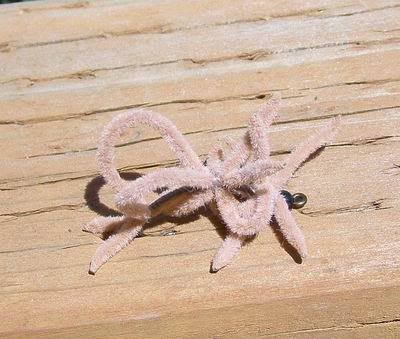Recently I have seen the light and become a true believer in the wonders of the worm.
It other words, it was the only fly that worked.
I can see this as being a BIG GUN specially after a storm or run off when the real thing gets washed up.
In the latest issue of Fly Rod & Reel, there was a fly that caught my eye
This thing has got to be killer on the conditions I mentioned.
Here is the SAN JUAN WORM BALL:
I had to tie some up in different colors:
Here is the article and the inventor:
Fly Tying: The San Juan Worm Ball
What could be better than one San Juan Worm? A bunch of them.
Dan Fink
The San Juan Worm has been a standard fly pattern for years now, because it's simple to tie and it works. So I thought, Why not take it one step further? If one worm is good, a bunch must be better. And it's true. The San Juan Worm Ball is a very fishable and effective pattern no matter what the purists might say.
To mess with your more closed-minded buddies, I recommend carrying your stash of newly tied San Juan Worm Balls to the river in a plastic bait container. The
K-Mart sticker is optional, as is any sort of pre-presentation dip in stinkbait juice.
Seriously, though, this fly works quite well for trout and panfish, despite its origins during a four-foot snowstorm that I spent in the company of a bottle of good bourbon. Drift it just like a San Juan Worm, with an occasional twitch to imitate a mass of irritated, doomed nightcrawlers.
Dan Fink lives high in the northern Colorado mountains, 12 miles from the nearest power line.
Recipe:
HOOK: Mustad 37160, size 10
BEAD: 1/8-inch tungsten
THREAD: 6/0 red Uni
BODY: Thread
TENTACLES: Worm-colored Ultrachenille, both regular and micro diameter
Crimp the hook barb. Slip the tungsten bead over the hook point and slide it to the eye, then place hook in vise. Attach the red thread and wrap a smooth, thin body back to the bend of the hook, only one layer thick. Coat with head cement.
Cut three pieces out of both regular diameter and micro thin chenille for a total of six segments. The two pieces for the back are two inches long, the middle pieces are 11/2 inches, and the front pieces are one inch each.
Tie on the two long pieces of chenille at the back of the hook. Wrap thread neatly and evenly up to the middle of the hook and make some worm-like loops with the chenille. Tie off at the middle of the chenille, leaving 1/2 to 1-inch ends.
Tie the two mid-length pieces of chenille on at the mid-point of the hook shank. Wrap thread up to just behind the bead. Make more worm-like loops in one or both of the middle pieces of chenille, and tie off right behind the bead head.
Tie on the remaining two pieces of chenille right behind the bead head.
Carefully flame every protruding end of the chenille with a cigarette lighter or match, tapering the ends so they look like the ends of worms. A rotary vise will help you avoid torching parts that shouldn't be torched.






 Reply With Quote
Reply With Quote